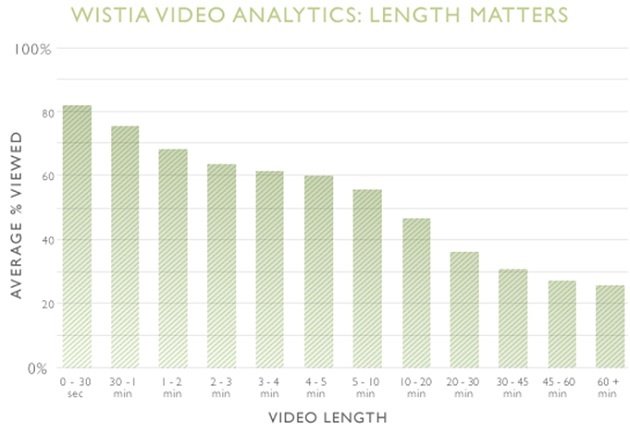
marketingprofs.com
By 2017, over 268 billion app downloads will generate $77 billion worth of revenue, according to Entrepreneur.
Those numbers are huge, and neither of them is terribly surprising.
Moreover, though $77 billion worth of revenue can sound like a blessing, it's actually much more of a curse.
After all, the app marketplace is crowded. And even the best app can get lost in the sea. Simply creating an app—even an amazing app—and introducing it via Google Play, Apple, or Amazon is not going to make you a success. In fact, a mere 0.01% of all mobile apps will be financially successful. And the reason 99.99% of apps don't succeed, TheNextWeb explains, doesn't come down to their functionality or usefulness; it's "because because they fail to get in front of their audience." In other words, the basic problem is marketing.
So, how do you get noticed in the sea of apps?
One of the most effective, data-driven solutions is investing in a demo explainer video.
Why? Videos are popular, have higher engagement rates than text, and are one of the most shared content types on social media. They're also persuasive.
For instance, Wyzowl—after surveying 251 companies in the marketing, advertising, and telecommunication industries for its 2015 State of Video Marketing report—discovered that 80% of respondents agreed or strongly agreed that video gave people a greater understanding of its company's product or service. A mere 5% disagreed.
Even more impressive, 73% of respondents said they'd gone on to buy from a company other than their own after watching one of that company's videos.
To help your app combat obscurity and bring your app to life, I've put together three reasons why your mobile app needs a demo video.
1. Showcasing
People like being shown exactly what they're getting. And a video (unlike text) can supply just that. That is even more important when presenting something new and technical.
Thankfully, that means mobile app demo videos don't need to be complex cinematic undertakings.
A screen-recorded explainer video—composed either mostly or solely of your app in action—can sound pretty basic. But don't let its simplicity overshadow its UX showcasing power.
Hours
Jeremy Olson, a co-creator of Hours, a time-tracking app that topped Angry Birds for downloads, attributed his app's success in large part to its demo video, especially during the launch phase: "Journalists love videos. It gives them a way to see if they are interested in the app before actually using it."
Hours' demo video places the app's easy functionality and visual beauty right in the viewer's hands by its demonstration of real-life use. It's also a quick video, so before you get bored with time tracking in general, you're asking yourself how Hours might assist your daily routine.
2. Connecting
App descriptions are notorious for being boring, bland, dry, and emotionless.
In fact, MarketingProfs recently called attention to this deficit in Are You Losing Sales Because of Boring Copy? A Widely Applicable Example of Apps:
"Your app description in the store has to tell the user not only what the app does but also how it'll change their life—by answering the questions they're asking themselves when they shop.
"And that's where most app descriptions fail.
"No matter how life-changing your app is for your customers, if the app description doesn't sell the concept to them, there's no way they'll buy."
Investing your app description with "life-changing" copy can be powerful.
But what do you do if copy alone isn't driving conversions—especially given the limited amount of space and headline restrictions provided in app stores?
The truth is videos hit us in the feelers. They stick to our emotions and therefore our thoughts.
However, don't think that connecting with your audience at an emotional level means your mobile app video has to be epic or even long.
Cumulative research by Wistia shows that, when in regards to videos, less is definitely more.

The fact that shorter is better is great news for mobile app videos, especially preview videos. The key to connecting is to:
- Go after the single most pressing problem your app solves, or
- Go after your target market's most dominant emotion
Runtastic
Runtastic is one of the most popular and most well-reviewed (in its Pro version) fitness apps online. And yet, its preview video (as required by app store regulations) is short, succinct, and free of fluff. Instead, the explainer video aims at addressing the most pressing problem newbies to the fitness world face: accountability. By highlighting the tracking and integrated social features, the app's preview video majors on the emotions that drive motivation.
Sky Guide
In contrast to Runtastic's problem-solution formula, Sky Guide's stargazing app video wordlessly directs its focus on a primary human emotion: awe. In just 30 seconds, the video walks through both the app's functionality as well as creates a genuinely emotional experience tied directly to its target market.
3. Answering
The sooner you can answer your audience's questions and objections, the better. And by "better," I mean more persuasive and more profitable.
That's why the last—and perhaps most powerful reason—to invest in a mobile demo video is that videos can be used to answer your audience before they even ask questions.
This reason rings true (once again) if your app's purpose is technical or innovative.
Salesforce recently highlighted the power of video throughout a sales funnel. What's more, it called special attention to FAQ videos usefulness at the end, or (in Saleforce's words) "to seal the deal." As the article points out:
"A well-positioned and thorough series of how-to and/or instructional video can provide your leads with the information they need, so they don't have to contact sales for a demo.
"As mentioned, 70% of the purchasing decision is made before your lead even communicates with sales and, for this reason, bottom of funnel content can also engage leads in the earlier stages."
Your website probably already has an FAQ section, which if drawing from only the most frequently asked FAQs, is an incredibly ripe source to generate content for your mobile explainer video.
Here are two fantastic examples of demo videos answering common questions.
WhizXpress
WhizXpress is an international calls app, which immediately raises a host of questions. Do the people I'm calling need the app, too? Is an Internet connection required? Can I place and receive calls? Does it facilitate video and conferencing?
In under a minute and half, WhizXpress answers each in turn while clearly addressing both personal and professional use.
Birdhouse
Birdhouse is Twitter augmentation app that allows you to "capture your ideas, save them for later, [and] publish when ready." The app explainer video, which is an Internet classic featuring "this bearded guy," walks viewers through the functionality of the app itself with a mix of screen recording intermixed with live video. Best of all it introduces and takes full advantage a character known as the "FAQ Jerk."
The stark contrast between $77 billion worth of revenue and the fact that 99.99% of apps don't succeed are hard realities of the app world. And there are no silver bullets.
But the power of videos to showcase your UX, connect with your audience, and answer their questions means that your mobile app needs a demo explainer video.
No comments:
Post a Comment